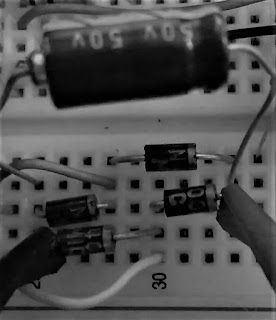We can develop the average DC output of the rectifier while reducing the AC variation of the rectifier output by using smoothing capacitors to filter the output waveform. Smoothing capacitors or condensers connected in parallel with the load through the output of the full-wave bridge rectifier further increases the average DC output because the capacitor acts as a storage device as shown below.
The smoothing capacitor converts the rippled full-wave output of the rectifier into a smoother DC output voltage. Now, if we run the simulator circuit with different values of the installed smoothing capacitors, we can see the effect on the rectified output waveform as shown in the figure.
5uF Smoothing Capacitor
The plot having blue color on the waveform displays the result of using a 5.0uF smoothing capacitor across the rectifiers output. Previously the load voltage followed the rectified output waveform down to zero volts. Here the 5uF capacitor is charged to the peak voltage of the output DC pulse, but when it drops from its peak voltage back down to zero volts, the capacitor cannot discharge fast because of the RC time constant of the circuit.
This outcome in the capacitor discharging down to about 3.6 volts, in this example, maintaining the voltage across the load resistor until the capacitor re-charges once again on the next positive slope of the DC pulse. In other words, the capacitor only has time to discharge briefly before the next DC pulse recharges it back up to the peak value.
In this way, the DC voltage applied to the load resistor drops only by a little amount. But we can develop this still by increasing the value of the smoothing capacitor as shown.
50uF Smoothing Capacitor
In this case, we have increased the value of the smoothing capacitor ten-fold from 5uF to 50uF which has reduced the ripple increasing the minimum discharge voltage from the previous 3.6 volts to 7.9 volts. Nevertheless, using the Simulator Circuit we have chosen a load of 1kΩ to achieve these values, but as the load impedance decreases the load current increases triggering the capacitor to discharge more quickly between charging pulses.
The effect of a providing a heavy load with a single smoothing capacitor can be reduced by the use of a larger capacitor which stores more energy and discharges less between charging pulses. Usually, for DC power supply circuits the smoothing capacitor is an Aluminum Electrolytic type that has a capacitance value of 100uF or more with repeated DC voltage pulses from the rectifier charging up the capacitor to peak voltage.
Nevertheless, there are two important parameters to consider when choosing a suitable smoothing capacitor and these are its Working Voltage, which must be greater than the no-load output value of the rectifier and its Capacitance Value, which regulates the amount of ripple that will appear overlaid on top of the DC voltage.
Too little a capacitance value and the capacitor has miniature effect on the output waveform. But if the smoothing capacitor is adequately large enough (parallel capacitors can be used) and the load current is not too large, the output voltage will be nearly as smooth as pure DC. As a general rule of thumb, we are looking to have a ripple voltage of less than 100mV peak to peak.
The maximum ripple voltage present for a Full Wave Rectifier circuit is not only regulated by the value of the smoothing capacitor but by the frequency and load current, and is calculated as:
Bridge Rectifier Ripple Voltage
Here, I is the DC load current in amps, ƒ is the frequency of the ripple or twice the input frequency in Hertz, and C is the capacitance in Farads.
The main advantage of a full-wave bridge rectifier is that it has a lower AC ripple value for a particular load and has a smaller smoothing capacitor than an equivalent half-wave rectifier. Therefore, the fundamental frequency of the ripple voltage is twice the mains frequency (100 Hz), but in the case of a half-wave rectifier it is exactly the same as the mains frequency (50 Hz).
The magnitude of the ripple voltage overlaid on the DC supply voltage by the diode can be substantially eliminated by adding a significantly improved π (pi) filter to the output terminal of the bridge rectifier. This type of low pass filter usually consists of two smoothing capacitors of the same value and a choke or inductor across them, introducing a high impedance path to the AC ripple component.
Another more practical and cheaper alternative is to use off-the-shelf 3-terminal voltage regulator ICs such as: B. Positive output voltage or vice versa LM78xx (“xx” is output voltage), negative output voltage LM79xx (datasheet) that can reduce ripple by more than 70 dB while providing constant output current Power supply of 1 amp or more.
